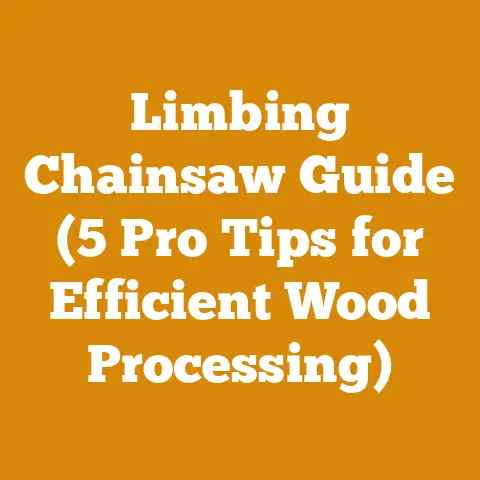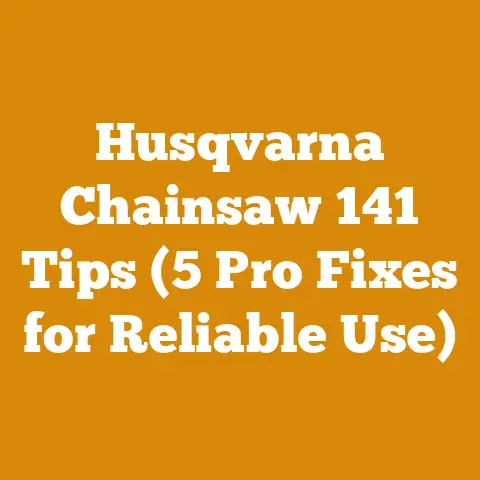Oregon Power Match Bar for Firewood Cutting (Top Picks for Tough Use)
Oregon Power Match Bar for Firewood Cutting: Budgeting for Tough Use
Let’s talk firewood. But sometimes, you get what you pay for, especially when you’re tackling tough wood or putting your saw through heavy use. This article isn’t about finding the cheapest bar; it’s about understanding the value of investing in quality and how to budget for it. We’ll explore the costs associated with using an Oregon Power Match bar for firewood cutting, considering everything from the initial investment to the long-term savings you might experience through increased efficiency and reduced downtime. Whether you’re a seasoned logger or a weekend warrior, knowing how to budget for quality tools is crucial. I’ll walk you through the factors that influence the price, how to determine if a Power Match bar is right for your needs, and strategies for maximizing your investment.
Understanding the Oregon Power Match Bar and Its Value Proposition
The Oregon Power Match bar is designed for professional users who demand durability and performance. Before we dive into the numbers, it’s important to understand why this bar commands a higher price tag.
- Durability: These bars are known for their hardened rails and replaceable sprocket nose, significantly extending their lifespan compared to standard bars. This is especially beneficial when cutting dense hardwoods like oak, maple, or hickory.
- Performance: The Power Match design optimizes chain speed and reduces friction, leading to faster cutting and less wear on your chainsaw. This translates to more firewood processed in less time.
- Replaceable Sprocket Nose: This is a game-changer. When the nose wears out on a standard bar, you have to replace the entire bar. With a Power Match, you simply replace the sprocket nose, saving you money in the long run.
- Versatility: They are available in various lengths and pitches, making them compatible with a wide range of chainsaw models.
But all these benefits come at a cost. So, how do you decide if it’s worth the investment? Let’s break down the pricing structure and cost factors involved.
Decoding the Pricing Structure of Oregon Power Match Bars
The price of an Oregon Power Match bar isn’t arbitrary. It’s influenced by several key factors. I’ve spent years working in the woods, and I’ve seen firsthand how these factors impact the final price you pay.
Bar Length and Gauge
- Longer Bars, Higher Prices: This is a no-brainer. More material equals more cost. A 20-inch Power Match bar will invariably be more expensive than an 18-inch model.
- Gauge Matters: The gauge refers to the thickness of the drive links on your chainsaw chain. The bar must match the chain’s gauge. Thicker gauges often indicate heavier-duty bars, which tend to be pricier.
Data Point: Expect to pay approximately $10-$20 more for every two inches of bar length.
Sprocket Nose Type and Replaceability
- Replaceable vs. Non-Replaceable: As mentioned earlier, the replaceable sprocket nose is a key feature of the Power Match bar. Bars with this feature will be more expensive upfront but offer significant long-term savings.
- Sprocket Nose Quality: Even within the Power Match line, there can be variations in the quality of the sprocket nose. Look for models with reinforced bearings for increased durability.
Bar Body Construction and Materials
- Steel Quality: The type of steel used in the bar’s construction plays a major role in its durability and price. Higher-quality steel will resist wear and tear better, but it also comes at a premium.
- Hardening Process: The process used to harden the bar rails also affects the price. A more thorough hardening process will result in a longer-lasting bar.
Retailer and Location
- Online vs. Local: Online retailers often offer lower prices due to reduced overhead costs. However, buying locally allows you to inspect the bar before purchasing and receive expert advice.
- Regional Price Variations: Prices can vary depending on your location. Areas with a high demand for logging and firewood equipment may see higher prices.
Data Point: Prices can vary by as much as 15% between online and local retailers.
Chain Compatibility and Pitch
- Chain Pitch: The chain pitch (distance between rivets) must match the bar. Different pitches are designed for different types of cutting.
- Chain Compatibility: Ensure the bar is compatible with your preferred chain type. Some bars are designed for specific chains, which can affect the overall cost.
Data Point: A high-quality chainsaw chain can cost anywhere from $30 to $80, depending on the length and type.
Estimating the Total Cost: A Detailed Breakdown
Now, let’s get down to the nitty-gritty. How much can you expect to spend on an Oregon Power Match bar for firewood cutting? I’ll break down the costs and provide real-world examples based on my experience.
Initial Purchase Price
- Price Range: Depending on the factors discussed above, you can expect to pay anywhere from $80 to $250 for an Oregon Power Match bar.
- Example: A 20-inch Power Match bar with a replaceable sprocket nose might cost around $150.
Data Point: As of Q4 2024, the average price for a 20-inch Oregon Power Match bar is $165, according to data from multiple online retailers.
Associated Costs
- Chainsaw Chain: Don’t forget the chain! A new chain is essential for optimal performance. Factor in the cost of a high-quality chain that matches the bar’s pitch and gauge.
- Bar Oil: Proper lubrication is crucial for extending the life of your bar and chain. Budget for a good quality bar oil.
- Sprocket Nose Replacement: While the replaceable sprocket nose saves money in the long run, you’ll eventually need to replace it. These typically cost around $20-$40.
- Tools and Accessories: You may need specialized tools for changing the sprocket nose or maintaining the bar.
Example Calculation:
- Bar: $150
- Chain: $50
- Bar Oil (1 gallon): $20
- Sprocket Nose Replacement: $30
- Total Initial Cost: $250
Long-Term Cost Considerations
This is where the real value of the Power Match bar shines. While the initial investment is higher, the long-term costs can be lower compared to using cheaper bars.
- Reduced Bar Replacements: A standard bar might need to be replaced every year or two, depending on usage. A Power Match bar, with proper maintenance, can last for several years.
- Increased Chain Life: The reduced friction of the Power Match bar can extend the life of your chainsaw chain.
- Less Downtime: Fewer breakdowns and repairs mean less downtime, which translates to more firewood processed and more money saved.
- Fuel Efficiency: A well-maintained Power Match bar can improve your chainsaw’s fuel efficiency, saving you money on gas or electricity.
Case Study:
I once worked with a logger who was initially hesitant to invest in Power Match bars. He was used to buying cheaper bars and replacing them frequently. After switching to Power Match, he found that he was replacing bars only once every three years, compared to twice a year with the cheaper bars. This resulted in significant cost savings over time. He also noticed an improvement in his chainsaw’s fuel efficiency and a reduction in downtime.
Comparing Oregon Power Match Bars to Alternatives
Okay, so the Power Match is great, but are there alternatives worth considering? Absolutely. The best choice depends on your specific needs and budget.
Standard Chainsaw Bars
- Pros: Lower initial cost, readily available.
- Cons: Shorter lifespan, more frequent replacements, potential for increased downtime.
- Best For: Light-duty use, occasional firewood cutting.
Other Premium Bars (Stihl, Husqvarna)
- Pros: High quality, durable, good performance.
- Cons: Similar price point to Oregon Power Match, brand loyalty may be a factor.
- Best For: Professional users who prefer specific brands.
Aftermarket Bars
- Pros: Lower cost than OEM bars.
- Cons: Variable quality, potential for compatibility issues, may void chainsaw warranty.
- Best For: Budget-conscious users who are willing to take a risk.
Cost Comparison Table:
| Feature | Oregon Power Match | Standard Bar | Aftermarket Bar |
|---|---|---|---|
| Initial Cost | $$$ | $ | $$ |
| Lifespan | High | Low | Medium |
| Durability | High | Low | Medium |
| Replaceable Nose | Yes | No | Sometimes |
| Performance | High | Medium | Variable |
| Overall Value | Excellent | Fair | Good |
(Scale: $ = Low, $$$ = High)
Maximizing Your Investment: Maintenance and Best Practices
Investing in an Oregon Power Match bar is only half the battle. To get the most out of your investment, you need to follow proper maintenance procedures and best practices. I cannot stress this enough – proper maintenance is the key to longevity.
Regular Cleaning
- Remove Sawdust and Debris: After each use, clean the bar with a brush or compressed air to remove sawdust and debris. This prevents buildup that can cause friction and wear.
- Clean the Sprocket Nose: Pay special attention to the sprocket nose. Remove any accumulated dirt or grime to ensure smooth chain rotation.
Proper Lubrication
- Use High-Quality Bar Oil: Don’t skimp on bar oil. Use a high-quality oil that is specifically designed for chainsaw bars.
- Check Oil Levels Regularly: Ensure the oil reservoir is always full. A dry bar will quickly overheat and wear out.
- Adjust Oiler Output: Adjust the oiler output on your chainsaw to match the bar length and wood type.
Chain Maintenance
- Sharpen Chains Regularly: A sharp chain is essential for efficient cutting and reduced wear on the bar. Sharpen your chain regularly using a file or a chain grinder.
- Check Chain Tension: Ensure the chain is properly tensioned. A loose chain can derail and damage the bar. A tight chain can cause excessive friction and wear.
- Rotate Chains: Use multiple chains and rotate them regularly to distribute wear evenly.
Sprocket Nose Replacement
- Replace When Worn: Replace the sprocket nose when it shows signs of wear, such as excessive play or damage to the bearings.
- Use OEM Replacement Parts: When replacing the sprocket nose, use genuine Oregon replacement parts to ensure proper fit and performance.
Storage
- Store Properly: When not in use, store the bar in a dry place. Consider using a bar cover to protect it from dust and debris.
Maintenance Checklist:
- After Each Use: Clean bar and sprocket nose.
- Weekly: Check chain tension and sharpness. Lubricate bar and chain.
- Monthly: Inspect sprocket nose for wear. Clean oiler port.
- As Needed: Replace sprocket nose. Sharpen or replace chain.
Budgeting for Firewood Cutting: A Holistic Approach
The Oregon Power Match bar is just one piece of the puzzle. To effectively budget for firewood cutting, you need to consider all the associated costs.
Timber Acquisition
- Free Wood: If you have access to free wood (e.g., from your own property or a friend’s), this will significantly reduce your costs.
- Purchasing Logs: Buying logs can be expensive, especially if you’re buying hardwood. Prices vary depending on the species, quality, and location.
- Permits and Fees: In some areas, you may need permits to harvest wood. Factor in these costs when budgeting.
Data Point: The average price for a cord of hardwood logs ranges from $100 to $300, depending on the species and location.
Equipment Costs
- Chainsaw: The chainsaw itself is a major investment. Choose a model that is appropriate for the size and type of wood you’ll be cutting.
- Chainsaw Accessories: Don’t forget the necessary accessories, such as a helmet, safety glasses, gloves, and chaps.
- Splitting Equipment: If you’re splitting firewood by hand, you’ll need a splitting maul and wedges. If you’re using a log splitter, factor in the cost of the splitter and fuel.
- Transportation: You’ll need a way to transport the logs and firewood. A truck or trailer is essential.
Data Point: A good quality log splitter can cost anywhere from $1,000 to $5,000, depending on the size and power.
Labor Costs
- Your Own Labor: Don’t underestimate the value of your own time. Factor in the time it takes to cut, split, and stack the firewood.
- Hiring Help: If you’re hiring help, factor in the cost of wages and benefits.
Data Point: The average hourly wage for a firewood cutter ranges from $15 to $25, depending on experience and location.
Fuel and Maintenance
- Chainsaw Fuel: Chainsaws consume a significant amount of fuel. Budget for gasoline or electricity.
- Log Splitter Fuel: Log splitters also require fuel.
- Equipment Maintenance: Factor in the cost of regular maintenance for your chainsaw, log splitter, and other equipment.
Drying and Storage
- Drying Time: Firewood needs to be properly dried before it can be burned. This can take several months, depending on the species and climate.
- Storage Space: You’ll need a place to store the firewood while it dries. This could be a shed, a woodpile, or a covered area.
Example Firewood Budget (1 Cord of Hardwood)
- Logs: $200
- Chainsaw Fuel: $30
- Log Splitter Fuel: $20
- Chainsaw Maintenance: $10
- Labor (20 hours @ $20/hour): $400
- Total Cost: $660
Note: This is just an example. Your actual costs may vary depending on your specific circumstances.
Cost Optimization Strategies for Firewood Preparation
Now that you understand the various cost factors, let’s explore some strategies for optimizing your firewood preparation budget.
Source Free or Low-Cost Wood
- Salvage Wood: Look for salvage wood from construction sites or tree removal projects.
- Contact Local Tree Services: Tree services often have wood that they need to get rid of.
- Harvest Wood from Your Own Property: If you have access to wooded property, harvest your own wood.
Invest in Quality Equipment
- Buy Used Equipment: Consider buying used equipment to save money.
- Choose Energy-Efficient Equipment: Look for chainsaws and log splitters that are energy-efficient.
- Maintain Your Equipment: Proper maintenance will extend the life of your equipment and reduce repair costs.
Optimize Labor
- Work Efficiently: Develop efficient cutting and splitting techniques to reduce the amount of time it takes to process firewood.
- Enlist Help from Friends and Family: Ask friends and family to help you with the work.
- Consider a Wood Processor: For large-scale operations, a wood processor can significantly reduce labor costs.
Properly Dry and Store Firewood
- Stack Firewood Properly: Stack firewood in a way that allows for good air circulation.
- Cover Firewood: Cover the firewood to protect it from rain and snow.
- Choose a Sunny Location: Store firewood in a sunny location to speed up the drying process.
Sell Excess Firewood
- Sell to Neighbors: Sell excess firewood to your neighbors.
- Advertise Online: Advertise your firewood for sale online.
- Sell at Local Markets: Sell firewood at local farmers’ markets or flea markets.
The Final Cut: Is the Oregon Power Match Bar Worth It?
So, is the Oregon Power Match bar worth the investment for firewood cutting? The answer, as with most things, depends on your individual circumstances.
Consider the following:
- Frequency of Use: If you only cut firewood occasionally, a standard bar may be sufficient.
- Wood Type: If you’re cutting dense hardwoods, the Power Match bar’s durability will be a major advantage.
- Budget: If you’re on a tight budget, a cheaper bar may be necessary. However, remember to factor in the long-term costs of replacement.
- Maintenance Habits: If you’re diligent about maintenance, a Power Match bar will last longer and provide a better return on investment.
My Recommendation:
For serious firewood cutters who demand durability and performance, the Oregon Power Match bar is a worthwhile investment. The replaceable sprocket nose, hardened rails, and optimized design will save you money in the long run by reducing bar replacements, extending chain life, and minimizing downtime. It’s a tool that pays for itself over time, especially if you’re tackling tough wood and putting your chainsaw through heavy use.
Actionable Takeaways and Next Steps
Ready to make a decision? Here are some actionable takeaways and next steps:
- Assess Your Needs: Determine how often you cut firewood, the type of wood you cut, and your budget.
- Research Options: Compare the Oregon Power Match bar to other alternatives, considering the pros and cons of each.
- Get Quotes: Obtain quotes from multiple retailers, both online and local.
- Factor in Associated Costs: Don’t forget to factor in the cost of a chain, bar oil, and other accessories.
- Plan for Maintenance: Develop a maintenance plan to ensure the longevity of your bar.
- Make a Decision: Choose the bar that best meets your needs and budget.
- Get Cutting! Put your new bar to work and enjoy the satisfaction of processing your own firewood.
Cutting firewood can be a rewarding and cost-effective way to heat your home. By carefully budgeting and investing in quality tools like the Oregon Power Match bar, you can maximize your efficiency and minimize your costs. Remember, it’s not just about the initial price; it’s about the long-term value and performance. Now, get out there and make some sawdust!






